
Paul Strand (1890-1976) is part of the canon of great photographers. He worked primarily during the first half to middle of the twentieth century in a style that can be recognised as modernist owing to his focus on form. His striking compositions were made in black and white and he was in many ways a documentary photographer who nevertheless practiced in an artistic manner.
Inspired by the Pictorialists, Strand was mentored by Steiglitz; he also went on to make films while in later life focused on Photobooks. He was a photographer of people in their environments and at times, used a specially constructed camera that appeared to be pointing in a different direction than it actually was which allowed him to catch people unawares.

a man using a selfie stick outside The V&A Museum
Although familiar with his still photographs, I have never seen any of his film work so this will be new to me. Strand also has a collection of images being exhibited at The Barbican as part of the Strange but Familiar exhibition that shows the work of photographers who came from outside Britain to photograph.
There is a review of the exhibition on the BBC website that cites the curator, Simon Barnes, saying “Strand is a kind of textbook you can go back to if you are a photographer to see how he dedicated his life to it” while also “He expanded the way we think about both fine art photography and documentary practice.” Steiglitz said of his pictures that they were “Devoid of film-flam; devoid of trickery and of any ‘ism, devoid of any attempt to mystify.”
It is interesting to note that research has been done into the people and places Strand photographed and many years later, some of his subjects have been found and recall the time they encountered a man whom one Italian woman described as serious looking; she had never seen a camera before!
Boyd Tonkin writing in The Independent about the photographs of Strand from the Hebrides, South Uist, states that “Strand makes form and history converge. Behind these artful compositions lies the work of time, and power.”
There does not appear to be a catalogue for this exhibition yet there is for an exhibition of the same name held at The Museum of Philadelphia in 2014. Strand’s book of South Uist photographs is due to be reissued soon
I think this exhibition is valuable because Strand is such an important photographer in relation to the development of photography. He is someone who helped to define photographic modernism and many of his images have become icons; the Blind Woman in New York is a classic example as it is understood to be a comment on the very act of looking with which photography is entwined.

I make my way through a busy London, the tourist season is now in force, and to the Victoria and Albert Museum; the exhibition is ticketed and after queuing, I make my way to the part of the V&A where photography is usually held. This exhibition is supported by American Friends of the V&A and the catalogue is the one produced for the Philadelphian exhibition.
I am not interested in “great photographers” but Strand’s work is interesting. His interest in “landscapes and communities” (exhibition commentary) is intriguing as is the “sharp focused style” while he is also remembered as a “champion of fine printing”; he “pioneered many of the styles and ideas that still concern photographers today” although I suspect these concerns may not be as mainstream as they once were.
It seems that Strand mastered the “Pictorialist” style thanks to Steiglitz!? Already, I am starting to pick up on differences of view between commentators though art movements such as Pictorialism and Modernism are not easy to define. Apparently, he was inspired “to create pictures with honesty, deeper meaning and intensity of vision.“
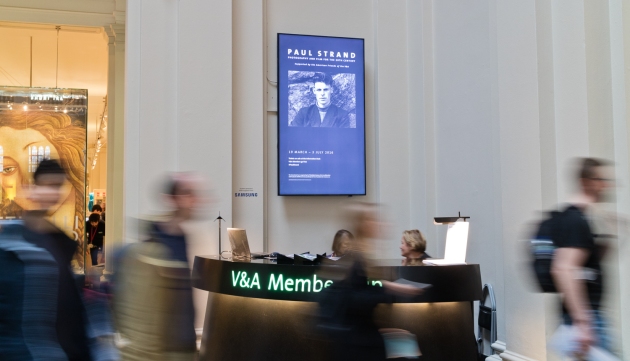
Commentary on the photographs extends to the compositional motif rather than merely cultural implications. Hence, the “White Fence” made in 1916 (the print here is from 1945) is discussed in terms of basic shapes and lines, the tonal range as well as the various layers, before mentioning the way it represents “aspirations and restrictions of American society.” The print is surprisingly soft, a reminder of the materials used at the time perhaps as well as an indication of his Pictorialist roots.
The Pictorialist pictures of landscapes are pleasant but for Strand these were “merely the expression of an impotent desire to paint“. He soon turned towards more social concerns as in portraits of ordinary people made surreptitiously on the street. Abstract compositions helped him to develop a sense of composition; these are mostly close ups. Although abstract in nature, a Cubist influence can be seen here. Views of New York have been carefully composed. A theme is the individual being dwarfed by the city.
While early photographs were made using the gum bichromate process, he also made platinum prints for much of his work while those printed later in 1945, are silver gelatin prints. His work also appeared in Camera Work.
After the first gallery, light grey walls with low lighting, there is a section for the showing of Manhatta, a film Strand made in 1921, that shows a day in the life of the great metropolis with quotes from Walt Whitman’s Leaves of Grass. It runs for 11 minutes on a large screen yet one smaller than in a standard cinema. Charles Sheeler also photographed with him. This film is on loan from The Museum of Modern Art (MOMA).
During the 1920’s (starting in 1919) he made a number of nature studies while holidaying in Maine using a 10 by 8 camera. The prints were contact print size and made using both the platinum and silver gelatin processes.
Intimate portraits include not just images of people such as his wife Rebecca but also Steiglitz as well as close ups of machinery. During the 1920’s, he was close to Steiglitz, his elder by 25 years, though later they had differences of view. Strand was using photography to explore close relationships, an approach he later abandoned.
Strand travelled. He apparently enjoyed making small photographs of big subjects. He photographed places that Ansel Adams was later to cover; although Strand does not have the technical controls Adams was to develop later, his work reveals a preciseness and control of contrast. Among his landscapes and portraits, there is also a constructed set that shows a skeleton hanging on a swastika. His work also reveals Christion iconography.
Native Land (1942) is a dramatic film that involves a chase of two men that starts outside a church. The men have asked for another 10 cents for their coffee and are relentlessly pursued. One is black and wounded yet he is helped by another, a white man, until both are spotted by a sniper who guns them both down mercilessly. The film shows the friendship of the white man towards the black man who he tries to help it in vain while there is the overtone of violence towards the workers. The film is dramatic in composition, showing for instance, only the arms and gun of the sniper to begin with before he shoots the two men down though we later see his face. The film ends with scenes of family life continuing nearby unaware of the violence going on as they live ordinary happy lives. It is situated in 1936.
The Wave from 1936 is almost biblical in approach as it shows a man asking villagers if they are ready to go fishing; the villagers are eager to and the film continues showing them the method of fishing by using a large net to draw a shoal of fish onto the seashore where they can be picked up the fishermen.
Fine prints from book projects seem to characterise the latter part of Strand’s life. He had a major retrospective show at the Museum of Modern Art in 1945. There is something pleasant about Strand’s choice of subject matter. At one point, there is an audio recording of a woman, Helen Bennett, who was photographed on her wedding day by Strand, as well as a similar set up for a photograph of her father which she says “Could not look any more like my father than it does!”
One thing that tends to characterise Strand’s work is evidence of Christianity both in images of iconography as well as buildings. Was Strand religious? He seems to have been political and left America because of anti-communism.
He visited France but it is his Hebridean images that have a particular resonance being a portrait of what was then and in a sense still is, a remote community. The breadth of his subject is interesting covering landscape, close ups of nature, portraits, buildings and their interiors. He was attracted to the place after hearing Gaelic songs from Uist on the radio and a recording of this plays in the exhibition.
Another body of work is titled Luzzara; this is about an Italian village and again focuses on the rural poor, a subject Strand focused on. Alongside the careful studies is detail, enough to allow captioning and give names to subjects.
Strand went on to visit other places including Egypt, Morocco and Ghana, photographing with the same distinctive approach.
He settled in Orgeval, north-west of Paris for the last 26 years of his life where he continued his “meditative exploration of nature” resulting in a large portfolio of six photographs as well as silver gelatin prints which are exquisite. He seems to gave a wonderful feeling for tone and chiaroscuro.
The exhibition ends with a photograph made by Martin Franck of Paul Strand carrying a large camera which is in a case nearby.
I spend a couple of hours going around the exhibition in preparation for the symposium tomorrow. On exiting, one is met with a variety of Paul Strand merchandise. Back to the real world? I decide to leave the purchase of the heavy catalogue until tomorrow, if at all, and go for a copy of photographs made towards the end of his life in the garden at Orveal. Although not actually a collector of photography books on nature, it is an enduring interest of mine.
Over at the Barbican exhibition, they are showing Paul Strand’s photographs from the Outer Hebrides. At the time, islanders were facing the onset of the modern world with the announcement that Uist would become a nuclear missile firing range, his photographs are said to reflect the dignified resilience of the people. The portraits are described as “stark and deceptively simple.”

The Victoria and Albert Memorial, passed on the way to the V&A
THE SYMPOSIUM (June 3’rd 2016)
Introduction by Matilda
Martin Barnesstarts by saying that his predecessor Mark Haworth-Booth wanted to do a Strand exhibition and finally it is being realised. A generation who has not seen Strand’s original work is benefiting.
One reason he curated this work is that Barnes wanted to know more about Strand! His enthusiasm a guiding force in rediscovering Strand and bringing his work to a wider audience. Much new research such as that by Peter Barberie (the next speaker) who has re-examined Strand’s work starting with the hard fact of the photograph; this is published in the catalogue. The exhibition accompanying this was first held at The University of Philadelphia and the one at the V&A is a slightly modified version of that.
Strand read a book “Spoon River” by Edgar Lee Masters that included poems. Trying to see into the minds of others! Strand in the second half of his career turned to book making as a way to support his photographs.
How can an art photographer be socially relevant!?
Colours used in book design influenced colour choices of walls in the exhibition. Strand posing his subjects as Renaissance artists did their subjects.
Visited Italy to see town where Strand photographed and met a woman who had been photographed by her. Also visited South Uist where Strand had worked while the exhibition includes audio of the Gaelic music that inspired Strand to go there. Available on the Smithsonian website.Ghanian imagery part of the colonial heritage.
Strand’s influence on photography immense such as his 1915-6 New York portraits in the street on Philip Di Corciawho also works surreptitiously. An example for contemporary practitioners!
“My mind was a mirror … Great scratches made on mirror … a scratched mirror gives no image, the silence of old age!” Lee Masters

Peter Barbarie
Peter Barbarie from Philadelphian a Museum of Art with whom Strand had contact; he curated a Strand exhibition held in 2014. Variations of his work are held by them, over 4,000 prints, the largest collection in the world. Talking about the American reputation of Strand which his exhibition set out to improve.
Early 1990’s, his reputation at something of a low. Key source on Strand from Washington National Gallery exhibition. Suggestion by Mr.Richard that Strand only made good work during his first decade; Andy Grundenburg was not much more encouraging citing Strand’s socialism.
Shows a photograph of a stone wall made by Strand in New England followed by the famous Wall Street photograph from 1915. W Strand’s early career his best time of working while the rest pales into insignificance. Strand saw his work as a continuing narrative.
1915 and 1916 described as Strand’s experimental era when he was close to Steiglitz. Joined a camera club in 1908 and work from 1910 survives. Strand a slow, thoughtful and stubborn artist who worked slowly. Tried again and again to get the kind of image he wanted! Influenced by artists and writers of the day thanks to Steiglitz. Discussions about Cubism. Strand making abstractions such as in the photograph of the fence in which shapes make up a complex image.
Strand’s photograph of a blind woman is part of another series which are street portraits made without the person being aware they were being photographed.
Walker Evans was much influenced by Paul Strand.
Strand photographing the distance between people yet later more interested in social cohesion.
Manhatta film about the passage of a day in New York City.
Strand desired but never got a mass audience. Wanted the whole world in his pictures.
Contact printed large format negatives which gave immense detail. Concerned that the technology would overtake the artistic vision.
Saw the changes taking place in New York. Interested in the passage of time.
Photographed his wife Rebecca. Earned a good living as a cinema-photographer; made a good study of the camera. Also photographed Steiglitz who could be a difficult character by insisting on his authority. A photograph of an old fashioned buggy made at Steiglitz’s home was not at all well received.
Strand only made photographic art now and then such as during vacations. Nature photographs in Maine. Spirituality in these photographs? Strand did not talk about them in such terms more concerned with mechanicaliry and organic. Falling out with artists such as O’Keefe who did not understand his process.
Rand regarded Steiglitz’s Equivalents as too subjective. Exploring photography”s ability to record the passage of time as in weather formations. Continued to use cameras with secret lenses. Saw Steiglitz as egotistical but was himself not a good collaborator! Strand took too long to make some work so it was no longer socially relevant by the time it came out.
Skeleton and Swastika was made in 1938; not a collage but a natural construction. A warning about Fascism.
Native Land a film with several subplots! Nspireational to other filmmakers even though it was not a success.
Photographs of architecture carefully composed.
Time in New England was a book in which she worked with Nancy Newhall.
At the end of the talk, as Barbarie is making his final comments, I make a couple of quick exposures. An American woman behind me starts complaining “Excuse me sir! Excuse me Sir!” and I heard her tutting when I held my arms behind her back for a moment. I remind her that photography is allowed here but clearly she seems my actions as interfering with her personal space.
Coffee outside! The talk has dragged on for almost a quarter of an hour longer yet it was a pivotal talk as it came from the curator of the Strand exhibition in Philadelphia.
I talk to a woman who comes from Brixton and is a photographer. She is black and I try but fail to elicit her ethnicity.
Meet Gill Golding, a former OCA student, who left to do an MA at Goldsmiths which she passed with a distinction.
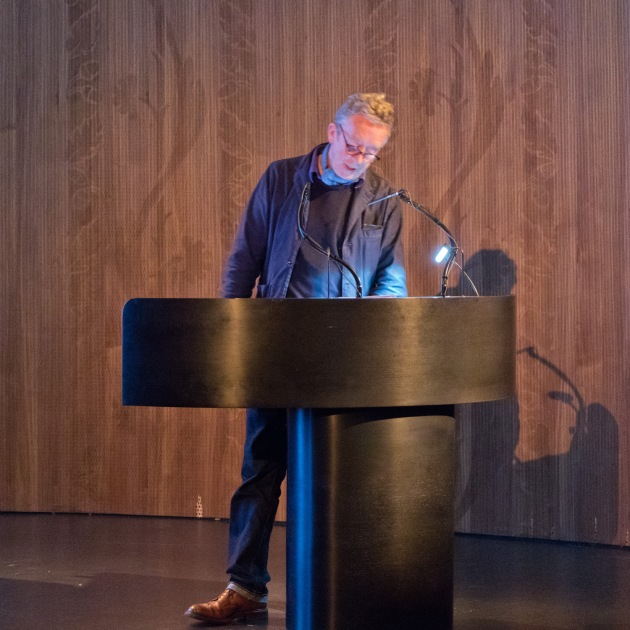 Sean O’Hagan
Sean O’HaganSean O’Hagan has travelled to Italy to where Strand photographed, unsure of what he might find. In fact, he came across a street sign that mentioned him. Strand an unknown, mysterious persona in photography.
Found scenery reminiscent of what Strand saw and was able to rediscover locations. Visited the place where Parmesan was and still is made using huge cheeses; this was the closest O’Hagan felt he got to the world Strand had photographed. Straight portraits.
He found the little girl that Strand photographed who remembered Strand as rather serious and even frightening with the machine under his arm. Strand was 63 when he visited Italy and the town of Lazarra! Social conscience still evident.
Helped to define photographic Modernism. Seeing the universal through the minute particular.
Lavazza not an obvious choice for a photographer but an astute one. People thought he might be a spy and the city had suffered politically in the past. Strand was largely unaware of this preferring to focus on his photography; lived in the tunnel of himself!
Strand was of his time. Sense of stoicism in his characters. Engaged with people through the camera.
The cover of this book in some versions has the photograph of the family gathered around a doorway. Slow living is part of Strand’s ethic!
Lot of images in this book that I have not seen before. Reasons for placement of images not easy to determine.
The Strands kept in touch with the villagers by sending them cards and photographs.
The Outer Hebrides book! “Had an infallible eye for the quintessential” Berger commented. This book in some ways a continuum of the Italian work.
Dr Barnaby Haran from the University of Hull talks about the radical ideas behind Strand’s work. Poverty and destitution, anti-fascism, economic decline … Strand covered some of the hard social conditions of the time. Critique of American capitalism as the cause was extant but not widespread; his famous Wall Street image perhaps conveys this.
Photographic close ups mirror illustrations of the time; an age that was struggling to come to terms with the machine. Time of documentary radicalism and modernism.
After Steiglitz, Strand connected with more politically active people. The social role of the camera.
Photographed a vernacular Jesus in Mexico. Detested capitalism! His film about fishing in Mexico an example of free trade! His Marxism set him against the state. Joined the new formed American Labor Party.
Also worked with Workers Film and Photo League. Quite a bit of political activity was going on and Strand was happy to identify with it. Photo League turned down its’rhetoric agter a few years. Aaron Siskind was another photographer involved.
Strand’s skeleton on a swastika is an example of Strand’s political work. Active Land is a pro-labour film and went further than much other work of the time. Concerned with civil liberties. Deals with “march of common man towards freedom!”
The Photobook as a means of supporting social change, American freedom. Time in New England was about this. Not really social commentary! Portraying history in the present.
LUNCH
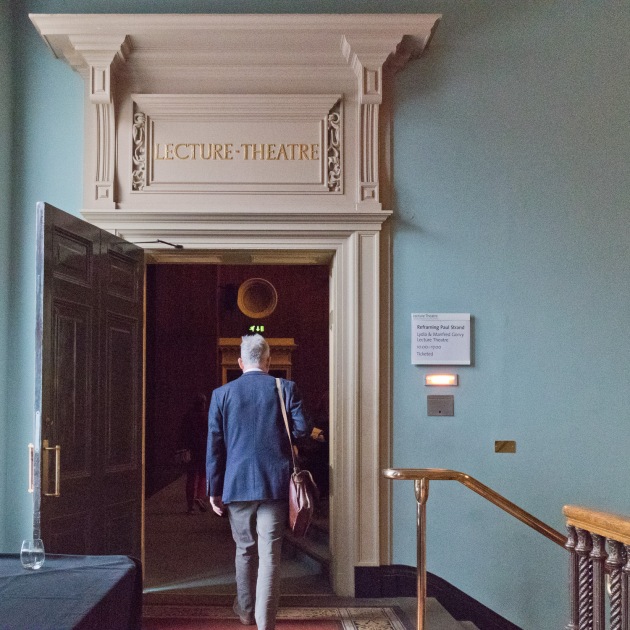
entrance to the lecture hall
Chat with Jill Golding, former OCA photographer, who moved to do an MA at Goldsmiths which she got with a distinction. She now works in photography and is going to Norway soon to show and talk about her work on sustainability.
Fraser MacDonald talking about the Hebridean photographs which he understands to be about Strand collaborating with the inhabitants. He wanted to work in the Celtic fringe! Saw Compton MacKenzie as a possible help but later rejected the idea.
Rocket testing in the Hebrides was an appalling idea to Strand.
Approached local doctor for help in approaching people. Dependency on local authority. Strand got help from Alaister MacLean who was famous at that time and supported his work there.
Sometimes sitters were paid. Other photographers have also visited as have other researchers and many of original photographs given to the villagers have dissappeared.
Children did not want to sit still while being photographed.
Other writers involved. Oldest surviving European culture (?) There was a retrospective of these photographs at Philadelphia in 1971.
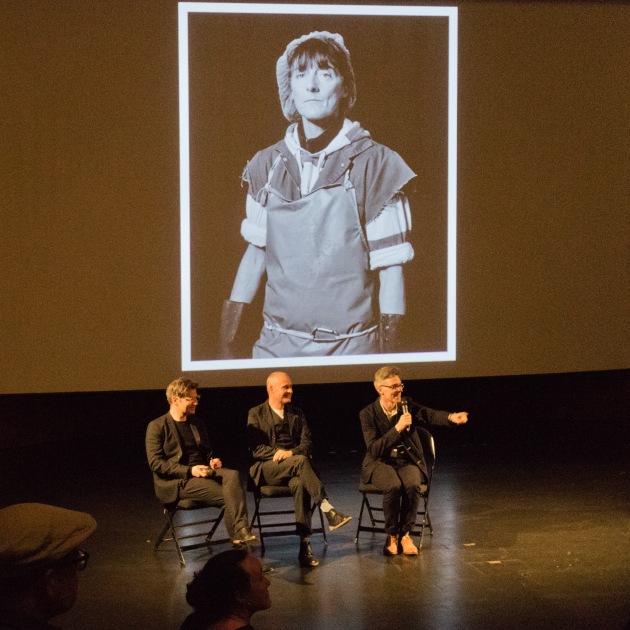
Paul Duke whose talk is called At Sea and is about work he has made concerning a fishing community in flux. Came into contact with the Italian work yet moved by the Outer Hebrides work which he considers the best of Strand’s work. About here and now! Subjects are responding to Strand the photographer! Speaker finds that studying work of photographers helps him to understand his own.
Picks out a photograph of a fisherman which he feels inspired by. Has also made work in a small fishing community. Became aware of the fear that they might have their boats decommissioned. Businesses on point of closing owing to fall off in fishing trade owing to European directives.
Referenced work of Hill and Adamson who made portraits of fisherfolk. Strand was also influenced by this work.
Made a lot of portraits in black and white of fishermen. Even though Scottish, he was considered an outsider. Catching a critical time in the history of this community, recording the dignity of people. Did not take many photographs, used film and found himself in harsh environments. Carried his own studio with simple background. Gender neutral representation of subjects. Quiet understated nature to images.
Influenced by people he met and their stories. Emotional encounters.
There is a discussion. Strand’s work not so well known in the places he photographed because the books were too expensive!
The artist has to be ease to make strong work …suggestion by Robert Adams! Was Strand at peace with himself? Are artists actually at peace when they make great work? Strand is said to have known himself yet also felt anger about some things. Perhaps the artist needs to be at one with himself as Strand seems to have been when making Hebridean photographs.
Paul not a neurotic creator says someone who knew him. Had come from a troubled background but bore it well. Hazel, his third wife, also loved taking photographs. Strand a genuinely nice guy who did not get irritated even when on location with difficult people.
Problems with Strand? Wanted to photograph photogenic members of the community. Sameness in the way he looks at people? Communist idea of looking for the perfect persona. Criticism tends to avoid this attitude of Strand which suggests he was trying to replicate an ideal. Conventional notion of the photogenic at work?
Strand always wanted to get a range of ages and genders. Did not want to represent people in an unflattering way, wary of being disrespectful. His earlier work on people in NYC made surreptitiously might have made him adopt this approach.
Strand encountered Diane Arbus’ photographs but found although the work was strong, it was also troubling.
Gaelic culture tends to talk about itself as being on the cusp of death! Strand seems to understand this.
Strand a perfectionist!. The perfect print for instance! Too flat, too black !!? There is a general feeling that the prints are too dark and even not sharp enough. What film did he use? Not common knowledge. Use lantern slides in the making platinum prints. Strand’s negatives could be the subject of another exhibition or book perhaps!?
TEA
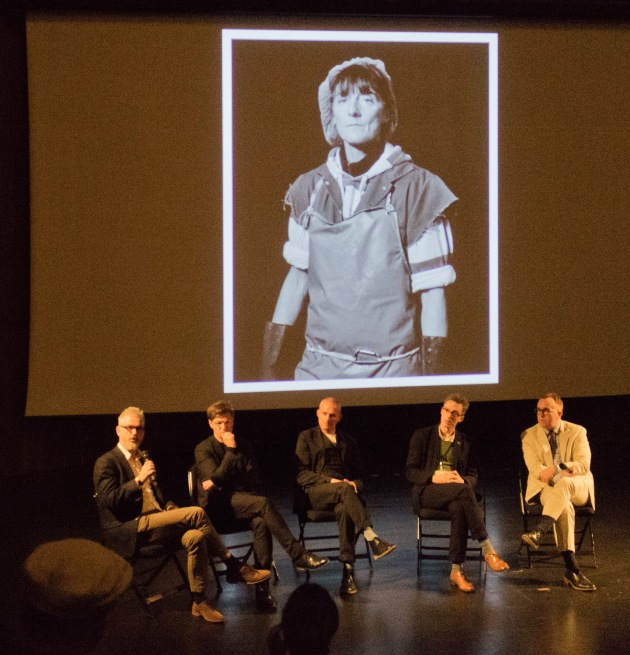
conversation between two Africans concerning Strand’s Ghanian photography. This conference about life and career of Strand through his work.
Foreign photographers not known as part of African art history.
Nii Obodai is the African photographer interviewed. No discussion of Strand but the occasional mention as Obodal has visited places Strand went to.
Obodal loves Diane Arbus; finds her work raw. Contemplates her writings such as “I rally believe there are things nobody would see if I did not photograph them.”
i_obodai@yahoo.com
Francis Nii Obodai Provençal
This is more like an artist’s talk rather than about Strand. However, during question time, Barbarai the American professor talks about Strand’s experience in Ghana.
Obodo reluctant to talk about colonialism as does he not identify with it; more inclined to talk about pre-independence.
click HERE for a link to my second visit to the exhibition with the Open College of the Arts
Pingback: “Oh! Why can’t we all be Modernists …” OCA meeting at the V&A for the Paul Strand exhibition. | Amano photographic studies